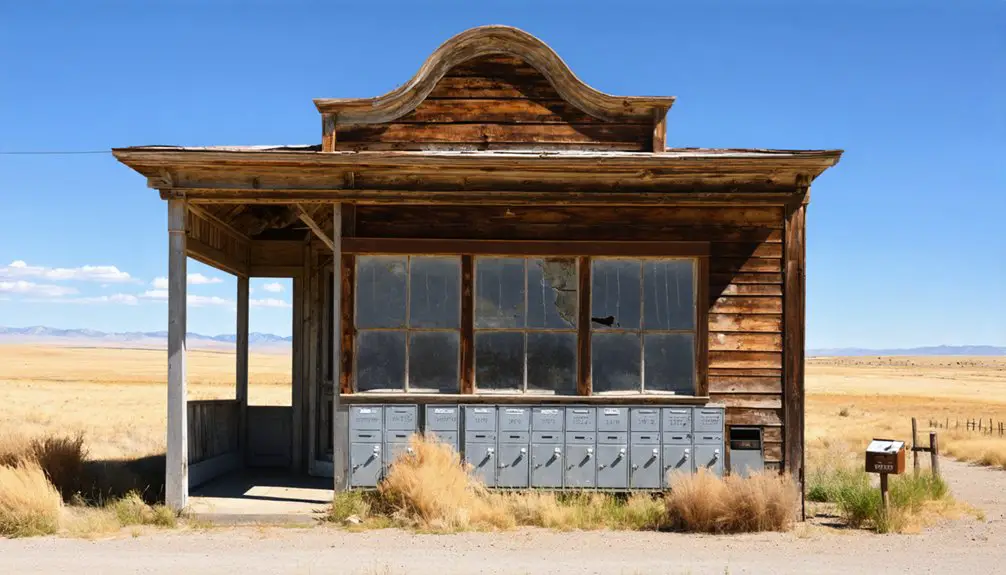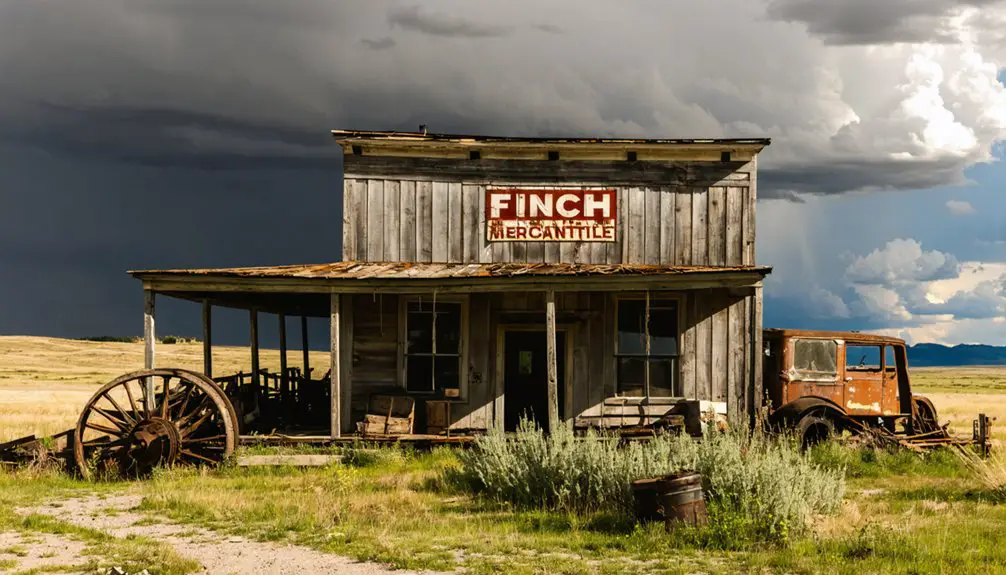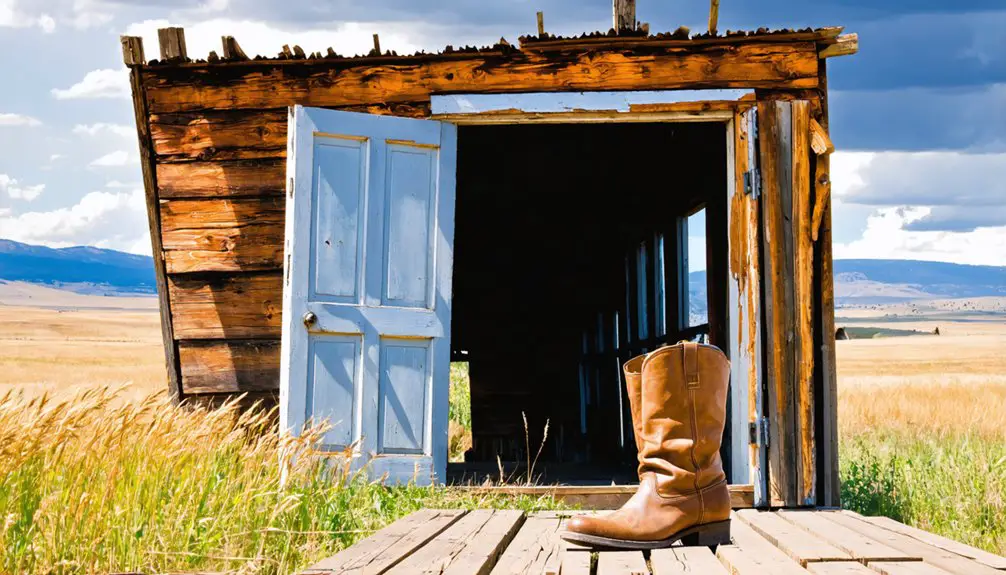You’ll find Finch, Montana as a former railroad section stop established in the 1880s between Hysham and Forsyth along the Northern Pacific Railway. Named after F.N. Finch, a division superintendent, the town supported railroad maintenance crews and operated a post office from 1914 to 1940. While most structures have succumbed to time, this ghost town‘s weathered remnants tell the story of Montana’s pioneering railroad era and the fleeting nature of frontier settlements.
Key Takeaways
- Finch was established in the 1880s as a strategic railroad section stop between Hysham and Forsyth along the Northern Pacific mainline.
- The town operated from 1914 to 1940, primarily serving railroad maintenance crews before declining due to technological advances.
- Daily life centered around railroad operations, with workers performing 12-hour shifts and gathering at community spots like saloons.
- Structures featured simple wooden construction with horizontal shiplap siding, built for immediate use rather than long-term durability.
- The town layout prioritized railroad access points, with buildings placed close together and infrastructure focused on transportation needs.
The Northern Pacific Railway Connection
The Northern Pacific Railway played three essential roles in Finch’s establishment and brief existence as a Montana settlement. As part of the railroad’s expansion across Montana Territory in the 1880s, Finch emerged as a strategic section stop between Hysham and Forsyth. You’ll find its name comes from F.N. Finch, who served as a division superintendent during this era of rapid railroad development. The final spike ceremony marked the completion of the transcontinental route with bands playing and celebrations.
The town’s history directly parallels the Northern Pacific’s infrastructure needs, serving as one of many control points positioned every 7-10 miles along the mainline. The company’s completion of the transcontinental line in August 1883 marked a pivotal moment for settlements like Finch.
While some section stops remained basic operational sites, Finch developed enough community presence to warrant a post office from 1914 to 1940. The railroad’s presence supported local maintenance crews and provided crucial transportation links for regional agriculture and commerce.
Rise and Fall of a Railroad Town
While many railroad towns managed to diversify their economies and survive, Finch’s destiny remained inextricably tied to its single purpose as a Northern Pacific section stop.
You’ll find that community resilience was nearly impossible without economic shifts beyond rail dependence.
Consider these critical factors in Finch’s eventual demise:
A town’s survival depends on adapting beyond its original purpose – a harsh lesson from Finch’s economic stagnation and collapse.
- Its role was purely functional – maintaining tracks and controlling operations every 7-10 miles along the line.
- The post office’s closure in 1940 signaled the community’s declining importance.
- Technological advances reduced the need for frequent section stops.
- Lack of mining, agriculture, or other industries left no reason for people to stay.
Named after F.N. Finch, the railroad superintendent, the town exemplified the common practice of honoring railway officials.
Today, you won’t find much evidence of Finch’s existence – just another Montana ghost town that couldn’t outlive its railroad utility. Unlike successful towns like Butte and Anaconda, which established vital mining and smelting operations by 1883, Finch never developed additional industries.
Daily Life in Early Finch
If you’d visited Finch in its early days, you’d have found railroad workers rising at dawn for their daily track maintenance, signal checks, and train scheduling duties along the Northern Pacific line.
The modest homes and section crew quarters, built for basic comfort and efficient heating, housed workers who spent long days ensuring the crucial rail connection between Hysham and Forsyth remained operational. Much like Garnet’s thirteen saloons that served its mining population, Finch had its own gathering spots where workers would unwind after their shifts. Similar to Fort Maginnis which employed 194 skilled craftsmen, these railroad workers brought essential expertise to develop the region.
After work, residents would gather at practical community spots like the post office, which served as both a communication hub and social center from 1914 to 1940.
Railroad Workers’ Daily Routines
Every morning before dawn, railroad workers in Finch began their grueling 12-hour shifts that would shape Montana’s expanding railway system. Despite constant workday hazards, these resilient crews demonstrated remarkable crew dynamics as they tackled the challenging terrain and harsh conditions that defined railroad construction in early Montana. Similar to the Northern Pacific Railroad, many companies initially hesitated to build lines into remote timber areas. The workers endured difficult living conditions in traveling bunkhouses, with limited access to basic necessities.
Your typical railroad worker’s day included:
- Morning track inspections and critical safety maintenance
- Midday operations involving dynamite blasting and bridge construction
- Afternoon clearing of debris and material preparation
- Evening planning sessions for the next day’s tasks
Working alongside fellow immigrants from the Midwest and Europe, you’d find yourself scaling dangerous heights on rope ladders, handling explosives, and operating heavy machinery.
These demanding tasks required unwavering focus and teamwork, especially in Finch’s remote location where self-reliance was essential for survival.
Community Gathering Spots
After long shifts on the railroad, Finch’s workers found solace and camaraderie in the town’s vibrant social spaces.
You’d find them gathering at the local saloon, where card games, storytelling, and news exchange filled the evening hours. The dance hall became the heart of community events, hosting celebrations that brought together miners, railroad workers, and their families.
The general store served as more than just a supply point – it was where you’d catch up on local gossip while purchasing necessities. Much like in Virginia City’s living museum, these gathering spots preserved the authentic feel of frontier life. Walking through these preserved spaces lets visitors imagine daily activities from generations past.
Social interactions flourished at the barber shop and hotel, while the church provided both spiritual guidance and a venue for community gatherings.
For more formal occasions, you’d head to the fraternity hall, where social clubs and organizations strengthened the bonds between Finch’s residents through regular meetings and events.
Housing and Living Conditions
Life in early Finch centered around modest wooden dwellings that reflected the town’s frontier spirit and residents’ practical needs.
You’d find these homes built with horizontal shiplap siding and simple brick chimneys, designed for quick construction rather than permanence. Housing adaptations over time showed how family dynamics shaped living spaces, as residents modified their cabins to accommodate growing households.
Your daily existence in a Finch home would’ve involved:
- Heating your cabin with wood stoves, essential for Montana’s harsh climate
- Drawing water from wells for cooking and basic irrigation
- Preparing meals on well-worn cooking ranges in small, efficient kitchens
- Making do with minimal insulation and weatherproofing, relying on features like shed-roof porches for protection
Post Office Operations (1914-1940)

When the Finch post office opened its doors in 1914, it marked the beginning of a 26-year period of continuous postal service that would prove crucial to this small Montana railroad community.
You’ll find that the post office played a critical role in connecting Finch’s railroad workers and residents to the outside world, handling both personal letters and business correspondence important for commerce along the Northern Pacific Railroad line.
As one of many section stops spaced 7-10 miles apart, Finch’s postal operations supported the broader transportation infrastructure until 1940.
The communication impact extended beyond mail delivery, helping establish Finch as a local control point for rail operations.
When the post office closed its doors in 1940, it signaled Finch’s eventual transformation into a ghost town.
Architectural Legacy and Remaining Structures
The architectural remnants of Finch tell a story of frontier pragmatism and rapid development along Montana’s Northern Pacific Railroad line.
Finch’s weathered buildings speak of Montana’s pioneering spirit, where speed and function trumped permanence along the railway’s edge.
Today, you’ll find a mix of deteriorating wooden structures that showcase the town’s utilitarian approach to construction, with most buildings lacking proper foundations and built for immediate use rather than longevity.
As you explore Finch’s remaining structures, you’ll notice:
- Simple rectangular frames with wooden clapboard siding and pitched roofs
- Closely-spaced buildings that once shared warmth in harsh winters
- Railroad infrastructure, including bridge supports, marking former transportation routes
- Minimal architectural preservation, allowing natural decay to convey authentic historical context
The town’s layout centered around its main streets and railroad access points, reflecting the practical needs of a bustling mining community focused on underground wealth rather than above-ground permanence.
Historical Significance in Montana’s Development

Founded as a strategic section stop along the Northern Pacific Railroad line between Hysham and Forsyth, Finch played an important role in Montana’s early transportation infrastructure and regional development.
Named after F.N. Finch, a railroad superintendent, the town supported crucial maintenance operations that kept Montana’s lifeline to distant markets functioning.
You’ll find its influence extended beyond the rails, as Finch served regional miners, ranchers, and farmers who relied on the railroad for moving goods and equipment.
The town’s post office operation from 1914 to 1940 marked its peak period of significance.
Like many small railroad communities, Finch’s importance diminished during the transportation evolution of the post-World War II era, reflecting Montana’s broader economic shift from rail-dependent industries to modern logistics networks.
Railroad Ghost Towns of the Region
Throughout Montana’s rail corridors, numerous ghost towns like Finch tell a compelling story of boom-and-bust cycles tied to railroad development.
These settlements emerged during the late 19th and early 20th centuries, showcasing distinctive ghost town characteristics shaped by their railroad heritage.
Montana’s forgotten railroad settlements stand frozen in time, preserving the unique architectural and cultural legacy of America’s western expansion.
When you explore these abandoned communities, you’ll discover:
- Preserved depots, mills, and rail infrastructure that once served as essential transportation hubs
- Historic hotels and saloons that catered to railroad workers and miners
- Remnants of warehouses and mining offices highlighting the towns’ economic foundations
- Well-planned but isolated communities that relied entirely on rail connectivity
The railroad impact on these towns proved both blessing and curse – while rails enabled their rapid growth, the eventual abandonment of lines led directly to their desertion, leaving behind silent testimonies to Montana’s dynamic past.
Frequently Asked Questions
What Was the Peak Population of Finch During Its Most Active Years?
You won’t find exact peak population numbers in historical records, but based on its role as a small railroad section stop, Finch likely housed between 20-100 people at its height.
Are There Any Known Photographs of Finch From Its Operational Period?
You won’t find any confirmed historical photography of operational-period Finch in town archives or public collections. Despite railroad documentation from that era, actual images of this section stop remain undiscovered.
Was Finch Ever Officially Incorporated as a Town in Montana?
No, you won’t find any incorporation history for Finch in Montana’s records. It maintained an unincorporated town status throughout its existence, functioning purely as a railroad section stop until its decline.
What Happened to the Residents of Finch After the Town’s Decline?
After the town’s decline, you’d find residents relocated to active mining towns, urban centers with war industries, or adapted by shifting to local ranching and farming work in surrounding rural areas.
Can Visitors Legally Access and Explore the Finch Ghost Town Site Today?
You’ll need to verify local land ownership before attempting ghost town access, as legal exploration depends entirely on whether Finch sits on private or public land – currently undocumented status suggests caution.
References
- https://www.garnetghosttown.org/history.php
- https://mightycaseybaseball.com/2015/08/13/the-three-ghosts-of-sumatra-montana/
- https://southwestmt.com/blog/ghost-towns/
- https://www.youtube.com/watch?v=wxA0j_uX7qg
- http://www.lostandfoundmontana.com/towns/finch.html
- https://www.geyserbob.com/northern-pacific-rr-1
- https://www.psmre.org/hist-np.htm
- https://en.wikipedia.org/wiki/Northern_Pacific_Railway
- https://archiveswest.orbiscascade.org/ark:/80444/xv68060
- https://montanaconnectionspark.com/2019/10/13/transportation-history-of-montana-railways/



